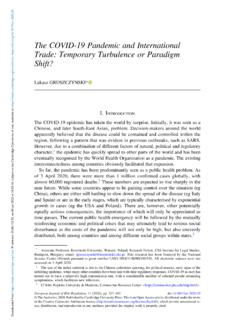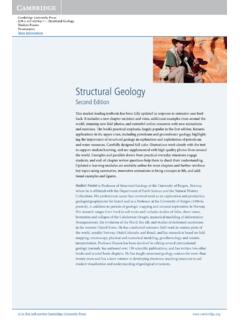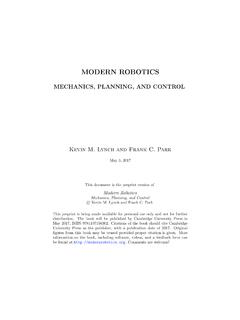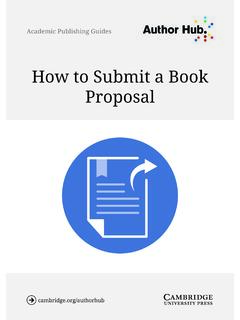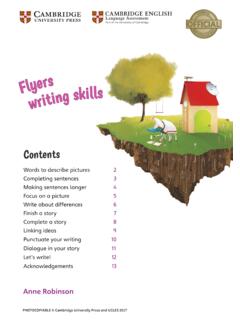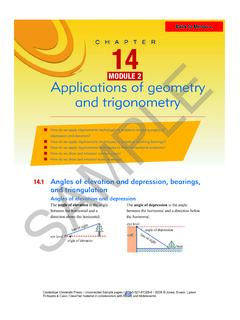Transcription of Giving feedback on speaking - Cambridge University Press
1 Giving feedback on speaking Part of the Cambridge Papers in ELT series December 2017 CONTENTS2 Introduction3 The case for Giving feedback5 Key decisions about feedback8 Including positive feedback10 Conclusion11 Recommendations for further reading12 Bibliography14 AppendixIntroductionIn any typical language learning course, students will be presented with a variety of opportunities to speak. Teachers often divide these opportunities into two broad categories: (1) activities that are intended to develop accuracy ( where the primary focus is on accurate production of language features, such as grammar, vocabulary or pronunciation), and (2) activities that are intended to develop fluency ( where the primary focus is on communicating meanings to another person, and not on the accurate production of language forms).
2 This paper will focus on feedback in the second type of activity, examples of which include discussions, debates, presentations, role plays, and problem-solving tasks. In each of these activities, there will be: some sort of outcome that is non-linguistic ( reaching a joint decision), some interaction between outcomes for such activities cannot be reliably predicted in advance, but the potential benefits include: gains in self-confidence and motivation; gains in automatized language production; opportunities to experiment with the full range of linguistic resources at the learners disposal ( develop more complex language); opportunities to learn from the language of other learners; opportunities to obtain feedback from other learners through the processes of clarification, rephrasing and confirmation, which will drive language the list above of potential learning benefits, it can be seen that fluency-based activities are concerned with more than just developing fluency.
3 Researchers have found that fluency-based activities can lead to greater accuracy and complexity (Nation & Newton, 2009: 152). At the same time, accuracy-based spoken work is generally believed to lead, ultimately, to greater fluency: otherwise, it would be a waste of time. Fluency and accuracy develop at the same time (Ellis & Shintani, 2013: 197).The challenge, for teachers, is to ensure that the conditions under which communicative speaking activities take place allow for these benefits to be realised. At the very least, it is important that students should (1) speak a lot, and (2) push themselves to use language at the upper range of their ability level (Ur, 2012: 117). One of the conditions that teachers control feedback can impact on these potential benefits.
4 feedback can also be about the performance of peers. In fact, some learners benefit more from hearing this kind of feedback than feedback which concerns them more directly. feedback is any kind of information that learners receive about their performance. This can be corrective feedback which focuses a learner s attention on errors, or it can be non-corrective, in the form of praise or encouragement, for example. However, the feedback can also be about the performance of peers. In fact, some learners benefit more from hearing this kind of feedback than feedback which concerns them more directly (Havranek, 2002: 259). It is also useful to bear in mind that feedback does not only go to the learner: it can also go to the teacher.
5 A student s performance in a communicative speaking task is a rich source of information about the teacher s teaching (Hattie & Timperley, 2007). In a fluency-based task, it is often the things that students did not say that provide the richest feedback to teachers. It is these gaps that can suggest the features of language that a teacher may wish to provide feedback on, especially in delayed feedback (see Should feedback be immediate or delayed? section)2 The case for Giving feedbackTo correct or not to correct at all: it is a question that researchers have debated for decades, but on which they have failed to reach clear agreement. Of course, not all feedback is corrective; it can also refer to praise and highlighting of successful language use, for example.
6 This paper addresses both sides of Giving feedback . First, we will consider on the correction of grammar (rather than vocabulary, pronunciation or discourse features), researchers such as Krashen (1982, 1985) and Truscott (1999) have argued that corrective feedback can be harmful to language acquisition, that it leads to no demonstrable gains in grammatical accuracy, that it can impact negatively on learners feelings, and that teachers face overwhelmingly complex decisions when they attempt to make corrective feedback effective in the classroom. Teachers, they argue, should consider dropping such feedback , in recent years, examination of the effects of feedback has led most researchers to disagree with this idea.
7 Drawing on a number of meta-analyses of corrective feedback , evidence is now pointing towards the idea that feedback can indeed promote language learning (Lyster et al., 2013; Ellis & Shintani, 2013: 257 268; Mackey et al., 2016). Learning gains may not be immediate or predictable, but they will take place. Teachers, argue these researchers, should not avoid corrective feedback , but should give more thought to the kinds of feedback they give. We will discuss the key decisions that teachers need to make about feedback below: when to give feedback , how to give feedback , and what kind of feedback to is now pointing towards the idea that feedback can indeed promote language learning. Research also suggests that students want and expect to be corrected.
8 In fact, they want to be corrected more than their teachers feel ready to do so (Roothooft & Breeze, 2016). This finding from research is uncontroversial: most adult learners in most educational contexts expect their errors to be corrected. They appreciate it when this takes place, believe that the teacher (as opposed to a classmate) is the best person to provide it, and prefer explicit kinds of feedback (Lyster et al., 2013: 7; Ellis & Shintani, 2013: 274; Zhang & Rahimi, 2014: 433).If students believe that their learning will be more effective when their errors are corrected clearly and immediately, there may be a strong case for providing more feedback of this kind. If teachers do not meet the expectations of their learners, we may also expect to find negative emotional responses which will be detrimental to learning.
9 Learners will only respond positively, however, if they believe that the feedback is something that will help them to improve. If they feel that the feedback concerns language that is above their level of competence, it is unlikely to be addition, the preference of most adult learners for a particular approach to corrective feedback does not mean that all adult learners share this view. Even among those who state that they want plenty of correction, there will be variations in the amount of correction that is seen as helpful. What one student perceives as helpful feedback , another may perceive as criticism. Furthermore, the fact that a learner expresses a preference for a particular approach does not necessarily mean that they will respond well to it (Mackey et al.)
10 , 2016: 503). Finally, we should not automatically assume that learners know what is best for them (Truscott, 1996: 359) and there is a danger that some learners may become too dependent on feedback from the teacher. They may not think enough about accuracy if they assume that the teacher will correct everything for most useful advice that can be given is that teachers simply need to be sensitive to the individual differences and preferences of their students. Rather than relying on their intuitive understanding, however, teachers may consider carrying out a survey with their classes in which students discuss their attitudes towards feedback . A good example of such a survey can be found in the Appendix section of this paper.





